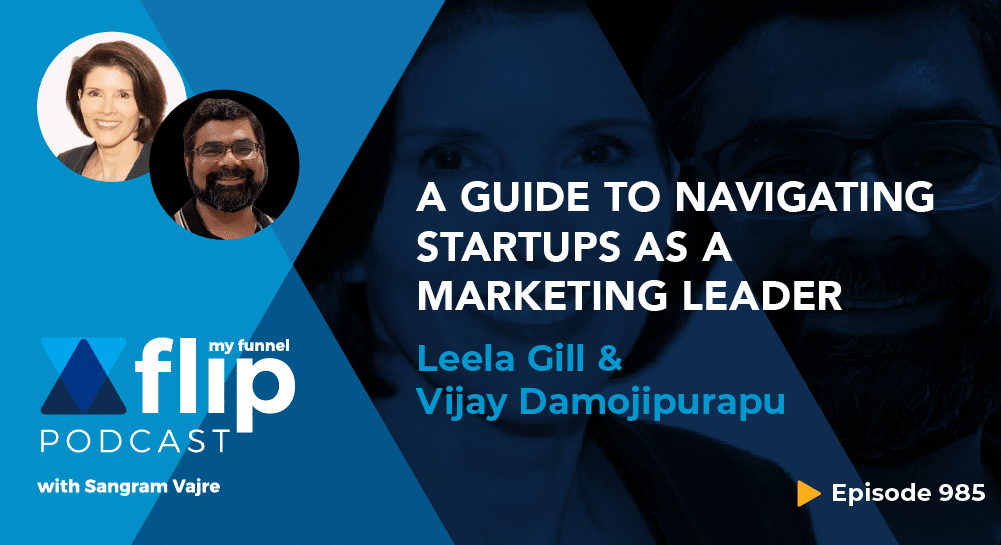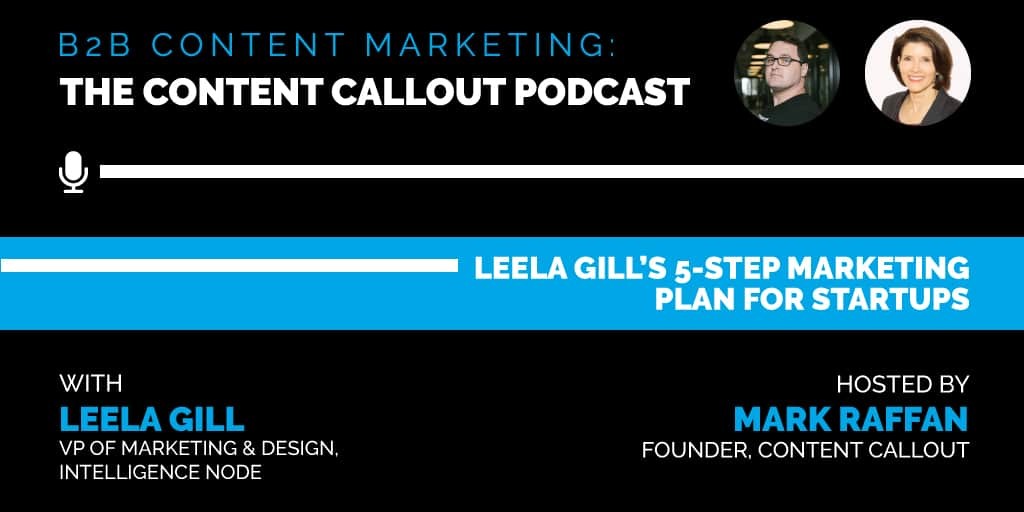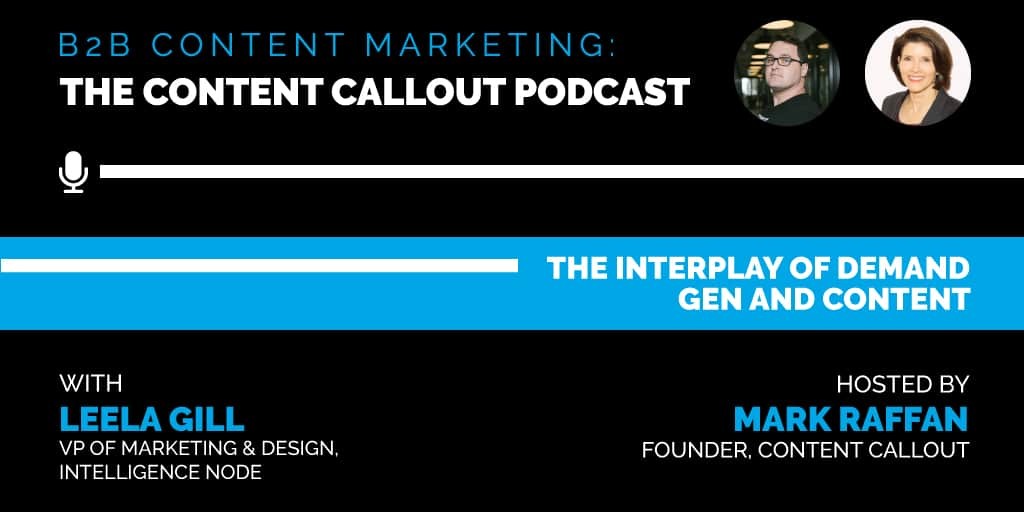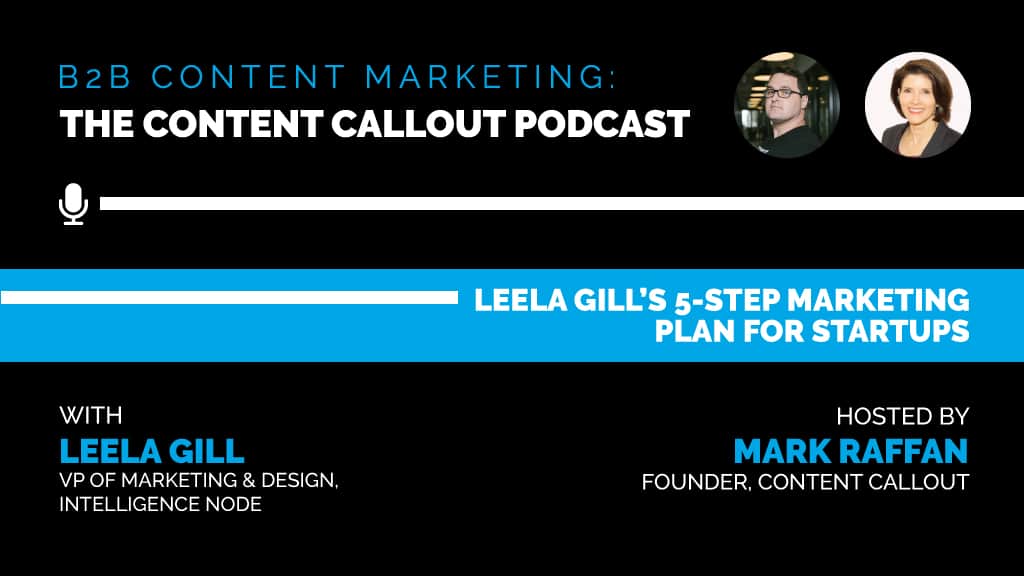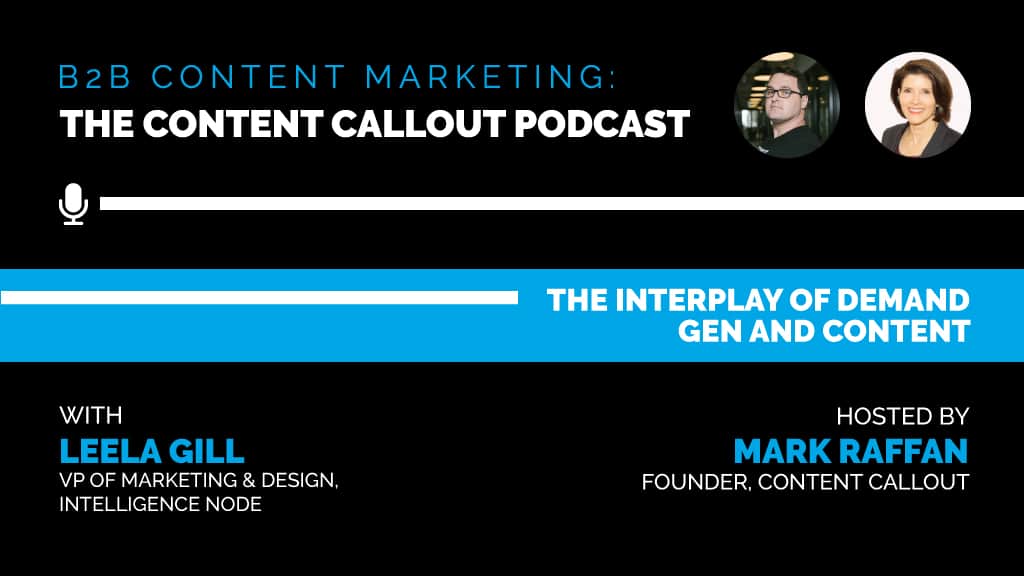A Guide To Navigating Startups as a Marketing Leader
It can’t be understated: Being a marketing leader of a startup can be crazy and chaotic. Out of the million tech startups formed every year, only 60% make it to series A, 20% make it to series B, and only 200 go IPO. The good news, however, is that once you make it, you have a strong chance of continued success.
Our guests today, Leela Gill, VP of Marketing & Design at Intelligence Node, and Vijay Damojipurapu, Founder and Principal at Stratyve, share two strategies to help grow your business and reinforce your position as a marketing leader.
Understanding what makes early stage company success so difficult
If you’re a leader in marketing trying to build a startup, it’s going to come with it’s fair share of hurdles; and with so little chance of success, it’s crucial to know the steps to take to be within the lucky few. For Leela, she connects the scenario to that of baby sea turtles making their way to the ocean — while the odds are stacked against them, the turtles that make it will live long and prosperous lives.
And to drive home just how important marketing is to the success of the business, a startup incubator in the San Francisco Bay area, called Wilbur Labs, recently surveyed over 150 founders. After collecting the results, they found that marketing ranked consistently higher than the product in regards to business success. If you’re looking to invest your time, make sure marketing is on the table.
Honing in on what specifically a marketer can do
Leela and Vijay recognize that investors will look at a few key factors when decisions are made: Leadership team skill, product power, market disruption, and how large the market is. While important, they’re looking to help enact change specifically as a marketer.
”We’re going to try to hone in on what you, specifically as a marketing leader, can do to help your company grow and thrive in this crazy competitive world of early stage business.” — Leela Gill
The operating framework
In the same way that we all know some of the more obvious ways to lose weight, like exercise and eating healthier food, the framework that Leela shares might have seemingly obvious, but often ignored, advice.
Time
Recognized as the first leg of the framework, this means to put together a formal quarterly cadence calendar that speaks to three different groups: The executive stakeholders, specific team members, and customers.
And, while there’s a high possibility that a similar setup is already in place, Leela warns that those meetings tend to focus on what to sell to the board rather than problem solving.
Money
Many startups don’t have the luxury of having millions or even one million to spend on marketing. Despite the desire to spend money on everything in the beginning, it’s important to invest in demand gen instead.
”When you have a limited budget, you have to really put the blinders on, focus, and make sure you’re executing that budget in a very prioritized way with respect to the pipeline.” — Leela Gill
Focus
This is more than just goal setting, it’s focusing on your exit criteria — what is going to help you survive as you transition to the next stage? If you get to series C, you’ll need to have documented processes in place.
The growth flywheel
Once you have the framework in place, where do you go from there? There has to be a way to push the boundaries to think and act differently. Vijay’s suggestion: You need an all-star CMO to pave the way for your team.
”Winning CMOS are consistent; they know it’s going to take a long time and they’re in it for the long haul.” — Vijay Damojipurapu
After interviewing several exceptional CMO’s, Vijay boiled down the insights:
- Content: The currency of a go-to-market machine. Used to earn credibility and trust.
“The content has to be unique, but it also has to be done on a consistent basis,” Vijay explains.
- Experiences: The CMO’s ability to create memorable events that focus on industry problems or speaking to the competitive ecosystem.
- Community: Sharing common pursuits and improving on a daily basis within the organization.
A key takeaway
Creating a successful tech startup can be a near impossible task. Arming yourself with the best strategies, like the operating framework paired with the growth flywheel, can give you the competitive edge that sets you apart from the crowd.
Related Posts:
Influencers, Brand Ambassadors and Raving Fans – and Why You Need All Three
For marketers, influencers, brand ambassadors, and raving fans can create a significant differentiator…
Marketing as a Revenue Generator and Catalyst for Change
Marketing is a change catalyst, calling customers to change and jump on, and it also helps the organization…
A Guide To Navigating Startups as a Marketing Leader
It can’t be understated: Being a marketing leader of a startup can be crazy and chaotic. Out of the million…
A 5-Step Marketing Plan for Startups
As a marketing professional working in a startup, do you know how to help your company grow revenue? How is…
Building A Diverse And Equitable Business: The Role Of Marketing
Jesse Jackson once said, “Inclusion is not a matter of political correctness. It is the key to growth.” This…
B2B Marketing: What We Can Do To Help Save The Planet
The COVID-19 pandemic is the biggest business challenge of a generation. Organizations scramble to establish…
The Interplay of Demand Gen and Content with Leela Gill
The COVID-19 pandemic is the biggest business challenge of a generation. Organizations scramble to establish…
Early-Stage Marketing: A Five-Point Leadership Framework
The COVID-19 pandemic is the biggest business challenge of a generation. Organizations scramble to establish…
Social Media: Getting Above the Noise
The COVID-19 pandemic is the biggest business challenge of a generation. Organizations scramble to establish…
A 5-Step Marketing Plan for Startups
As a marketing professional working in a startup, do you know how to help your company grow revenue? How is your process different from marketing for an established business? In this episode, Leela Gill drops some absolute gems when she describes her marketing plan for Series A and Series B startups. If you’re trying to get your marketing off the ground and running, don’t miss this episode!
Outline of This Episode
- [1:10] Why Leela created her cheat-sheet
- [2:35] Step One: Audit where you currently stand
- [5:02] Step Two: Understand your budget + costs
- [9:06] Step Three: Understand your team’s skillset
- [12:21] Step Four: Think about the big picture
- [16:54] Step Five: What are your exit criteria?
- [19:03] Metrics that matter for scaling up
#1: Audit where you currently stand
The first step in Leela’s plan is auditing where you currently stand. It’s a step that every marketing leader does when they come into a company. But Leela advises auditing every quarter. It involves looking at your ideal customer profile and personas and making sure they’re correct. Does your value proposition work? You have to look at the fundamentals. Then look at your CRM and make sure it’s functioning properly. Encourage your team to be problem solvers.
#2: Understand your budget + costs
You need to understand your budget, costs, conversion rates, and the ecosystem you have to operate in. In a Series A/Series B, your budget can be very constrained. It’s unlikely that you’ll have large tech stacks and an unlimited marketing budget. If that’s your environment, you’re lucky because it’s uncommon. You have to figure out how to make the most of the budget you get, right? Leela usually allocates 40–45% of her budget to headcount and the rest to programs. You need to split your budget in a way that gets you people power and program power to execute. Listen to learn more about what Leela means by that!
#3: Understand your team’s skillsets and strengths
Put people in places where they’re strong. Don’t force people to learn by throwing them in the fire and seeing if they’ll survive. If you don’t have a strong subject matter expert (SME), find a content person that can execute within that area of expertise. Leela does quarterly performance reviews with her team members. In an early-stage company, you can’t wait a full year to review where your content, performance, budgets, and team skill sets are at.
#4: Think about the big picture
Every business is in business to grow revenue, but it’s especially important in the early stages of a business. Leela takes revenue, conversion numbers, conversions rates, etc., to work backward to determine what MQLs/SQLs will be. Then she maps targets to specific programs. If you need 200 leads per week, how will you drive them? How did you do last quarter? Did you hit your numbers? Why did you or didn’t you? Asking the right questions helps you determine what you need to do more of.
#5: What are your exit criteria?
Your goal as a marketer in Series B is to help your company get to Series C or exit the process. In Series A, you need to test your frameworks, understand what’s working, test your ICP and understand your personas, etc. You need a model in place to understand how many leads you’re bringing in. The next logical step is to grow. Series B is all about scaling. If you have a segmented database, make sure a process and cadence are in place to scale and get to Series C.
Leela takes a deep dive into each of these steps in this episode. Don’t miss it!
Related Posts:
Influencers, Brand Ambassadors and Raving Fans – and Why You Need All Three
For marketers, influencers, brand ambassadors, and raving fans can create a significant differentiator…
Marketing as a Revenue Generator and Catalyst for Change
Marketing is a change catalyst, calling customers to change and jump on, and it also helps the organization…
A Guide To Navigating Startups as a Marketing Leader
It can’t be understated: Being a marketing leader of a startup can be crazy and chaotic. Out of the million…
A 5-Step Marketing Plan for Startups
As a marketing professional working in a startup, do you know how to help your company grow revenue? How is…
Building A Diverse And Equitable Business: The Role Of Marketing
Jesse Jackson once said, “Inclusion is not a matter of political correctness. It is the key to growth.” This…
B2B Marketing: What We Can Do To Help Save The Planet
The COVID-19 pandemic is the biggest business challenge of a generation. Organizations scramble to establish…
The Interplay of Demand Gen and Content with Leela Gill
The COVID-19 pandemic is the biggest business challenge of a generation. Organizations scramble to establish…
Early-Stage Marketing: A Five-Point Leadership Framework
The COVID-19 pandemic is the biggest business challenge of a generation. Organizations scramble to establish…
Social Media: Getting Above the Noise
The COVID-19 pandemic is the biggest business challenge of a generation. Organizations scramble to establish…
The Interplay of Demand Gen and Content with Leela Gill
Demand gen and good content should go hand-in-hand. But the level of competition for businesses in Series A/Series B funding is intense, and very few make it out of startup mode. So what does it take to get to the next level? How can you develop great content and demand gen? What do you prioritize? Leela Gill answers these questions and more in this special two-part episode series of the Content Callout podcast!
Outline of This Episode
- [1:50] Major challenges to scale Series A/Series B businesses
- [6:13] Develop the demand gen engine
- [9:39] How to understand the “need”
- [11:45] How to approach the development of content
- [16:17] Create a feeling in the reader
- [19:40] How to connect with Leela Gill
Major challenges to scale Series A/Series B businesses
According to Leela, Statista says there are over 1 million startups formed globally every year. The average age of a startup is between 5–10 years. Sixty-one percent of startups are B2B and 39% are B2C. And only approximately 4,300 startups exit the ecosystem. Of those, 200 are “unicorns,” 100 of which are from the United States. That’s the world you’re stepping into as a marketing leader.
Startups go through seed funding, Series A, Series B, Series C, and Series D/E. Leaders in the A and B world are clawing for survival. There are a lot of challenges that require a certain personality to be successful. You have to do a lot with very few resources. You’ll likely have a small marketing budget, and you need to ramp up revenue.
In Series B, you get a few more people and a little more money, but you have to triple your revenue growth. What personality goes into that world? Someone innovative, ready for a challenge, and willing to be a catalyst for change. They are creators at the heart of what they do.
What should you prioritize?
The level of competition is intense when you reach Series A/B. There are so many pressures to do everything all at once. Prioritization is critical at this level. Pipeline and demand gen is the growth engine of your business. If you aren’t growing, you’re out of business. So you must prioritize demand gen followed second by content.
They’re intertwined, but you can find success with demand gen with just a few pieces of content. Leela believes demand gen is getting your message out to as many people as possible—the traditional method. But she also believes in having a target account list that is personalized and that you go after that messaging.
Create a need for your products
There’s another element to demand gen: creating a need for your products. That’s the golden nugget. You need to understand your customer’s pain points so well that you create a need. You make your product a must-have.
Who actually needs bottled water? In the ’80s, big CPG companies convinced the world that the water coming out of their tap wasn’t adequate. Suddenly there was a huge marketplace around purified bottled water. It’s a great example of marketers creating a need for a product.
What need can you create in your ecosystem? It should be an authentic and true need—you want to be ethical. Finding an actual need is the crux of demand generation. Too many people start with product marketing that isn’t aligned with a need, and it becomes hard to sustain campaigns. But if you base your marketing on the major pain point, frustration, or the opportunity, it helps to maintain the content and demand gen.
How to understand the “need”
Understanding the need begins with talking to your customers. Why did they choose to buy your product? Actively listen for keywords they use around their pain points. If you can prioritize that, your messaging will be better than others.
The major need people have around content is typically for building SEO and rankings. But the problem is that they have no time to create content themselves. The frustration and pain point is the project management of freelance writers and content creators. The opportunity is the SEO and thought leadership, but the pain is associated with the management. Once we keyed in on that for Content Callout, it accelerated our growth.
How does Leela approach the development of content to create a feeling in readers or listeners? Listen to the whole episode to learn more!
Related Posts:
Influencers, Brand Ambassadors and Raving Fans – and Why You Need All Three
For marketers, influencers, brand ambassadors, and raving fans can create a significant differentiator…
Marketing as a Revenue Generator and Catalyst for Change
Marketing is a change catalyst, calling customers to change and jump on, and it also helps the organization…
A Guide To Navigating Startups as a Marketing Leader
It can’t be understated: Being a marketing leader of a startup can be crazy and chaotic. Out of the million…
A 5-Step Marketing Plan for Startups
As a marketing professional working in a startup, do you know how to help your company grow revenue? How is…
Building A Diverse And Equitable Business: The Role Of Marketing
Jesse Jackson once said, “Inclusion is not a matter of political correctness. It is the key to growth.” This…
B2B Marketing: What We Can Do To Help Save The Planet
The COVID-19 pandemic is the biggest business challenge of a generation. Organizations scramble to establish…
The Interplay of Demand Gen and Content with Leela Gill
The COVID-19 pandemic is the biggest business challenge of a generation. Organizations scramble to establish…
Early-Stage Marketing: A Five-Point Leadership Framework
The COVID-19 pandemic is the biggest business challenge of a generation. Organizations scramble to establish…
Social Media: Getting Above the Noise
The COVID-19 pandemic is the biggest business challenge of a generation. Organizations scramble to establish…
Social Media: Getting Above the Noise
With more than 4.2 billion social media users around the world, a number that has grown 490 million YoY from January 2020 to 2021, it can be challenging for a brand to stand apart from the crowd. To get above the noise and attract attention from prospects, you need to create a conversation. How do you do that? A major consideration is to be cognizant of the platform you’re using and formulate your messaging accordingly. The type of content — and the way you message it — should be different on LinkedIn vs. Instagram, for example.
Social media use has soared over the last decade and has impacted our lives in significant ways — connecting people, facilitating social shopping, and even boosting businesses. In 2020, 500 million tweets were sent each day, LinkedIn experienced a 55% increase in conversations amongst its users, and close to nine million pictures were uploaded on Instagram on a daily basis. Though considered a ‘creative outlet,’ social media imposes significant risks on individuals if not handled carefully. Social media today is like TV was in the 60s; it is embedded and part of the global discourse. Tap into it not just for business but for positive social outcomes.
The Power of Social Media
Whenever there is notable scientific progress that radically converts the way individuals live, it creates discourse over the essence of that change and whether it drives a “positive” or “negative” impact in our society. Social media networks such as Instagram, Facebook, and LinkedIn — as well as newer additions to the social media playing field like TikTok and Clubhouse — have transformed the way people get news and converse with one another.
A prime example of the power of social media is its recent influence over stock trading. The infamous GameStop stock that had surged as much as 1600% in January wasn’t merely a meme stock upended by Reddit forum WallstreetBets. It was more about fighting against corruption in the financial market manipulated over the many years where the ultra-rich and wealthy hedge fund managers got richer while ordinary people that didn’t have much lost everything during the 2008 financial crisis. For the lucky ones “in the know,” purchasing GameStop was an opportune moment to manipulate the market and reverse circumstances where hedge fund managers lose money.
Another example of a powerful social media platform is TikTok, the most downloaded app on the Internet. The app’s usage skyrocketed during the beginning of the COVID-19 pandemic, when people suddenly had a lot more time to spend at home scrolling their phones. Content creators on the app upload 15-60 second videos for anything from, teaching new hacks, participating in viral dance-offs or cook-offs, or even providing opportunities for Gen Z to find remote internship and volunteering opportunities. TikTok has become a new era of digital social change, turning regular people into content creators who now have opportunities to sign modeling, music, and acting contracts. Part of its allure is that it gives an average Joe a chance to build something from nothing.
The latest app taking the Internet by storm is Clubhouse, an interactive audio-based social network that is advocated by some of the most influential people worldwide including Elon Musk. This exclusive invite- and iPhone-only app cannot be downloaded by just anyone from the App Store. It’s essential to note that it’s the consumers that created this domain of partnership over rivalry. It is rare in the social media community but predictable considering how they set up their access – beginning with a meticulously administered group of investors, influencers, entrepreneurs, and artists and allocating them a restricted number of invitations. The app started with the right individuals that shaped the platform and then had them bring on new users who were ingrained into this culture. The outcome was a healthy and reared environment in which users could acquire entry to an extensive network of people and opportunities that were formerly unattainable.
As mentioned above, social media has had some beneficial effects in allowing people to connect and giving them opportunities they may not have otherwise. However, they can also be platforms for some toxic and harmful conduct. Facebook’s long-stated purpose is to “bring the world closer together.” It considers itself a non-discriminatory platform and has made efforts to combat against editing its users’ speech. That hasn’t been entirely effective; many people still believe it can promote hate and a divided society. This has resulted in Facebook coming under fire in recent years and has led to loss in its consumer trust.
Clubhouse and TikTok’s new social media format are exploding because the other channels such as Twitter and Facebook are too “noisy” and not trusted.
Engaging Influencers to Start a Conversation
Engaging the proper influencers on every new social channel helps brands establish various platforms to deliver their message. It is a critical yet effective way to reach a larger audience, raise brand awareness, strengthen trust for your brand, augment your social following, boost site traffic and drive sales. Companies use this approach to endorse their products and services by merging with prevalent social media users or bloggers. Influencers typically have a large following with an engaging audience that aids brands build credibility and boost sales. Brands may also want to consider partnering with micro-influencers, folks who have smaller — but highly engaged and targeted — followings.
Finding your Niche
It’s important to understand that most consumers aren’t looking for brands with a massive following. Instead, they look for authenticity, trust, and a great deal of passion in the content they follow and engage with. Finding your niche to grab your audience’s attention may seem like a daunting task, but you do not always have to create novel content to stand out. Rather, the key is to be specific; ensure your social media presence matches the values of your brand. You do not have to have the current iPhone or a brand new camera model to begin. Influencer MrBeast filmed his first video eight years ago in his bedroom using a webcam, and now he boasts close to 55 million subscribers on YouTube and 12.3 million followers on Instagram. His goal wasn’t to sell his brand but to inspire his audience. Keep experimenting, improve your craft, be consistent, and of course, enjoy the process—brands aren’t born overnight; they are built over time.
Stimulating segmentation through a compelling story aids in building a stronger community — using this formula can get your brand above the noise.
Related Posts:
Influencers, Brand Ambassadors and Raving Fans – and Why You Need All Three
For marketers, influencers, brand ambassadors, and raving fans can create a significant differentiator…
Marketing as a Revenue Generator and Catalyst for Change
Marketing is a change catalyst, calling customers to change and jump on, and it also helps the organization…
A Guide To Navigating Startups as a Marketing Leader
It can’t be understated: Being a marketing leader of a startup can be crazy and chaotic. Out of the million…
A 5-Step Marketing Plan for Startups
As a marketing professional working in a startup, do you know how to help your company grow revenue? How is…
Building A Diverse And Equitable Business: The Role Of Marketing
Jesse Jackson once said, “Inclusion is not a matter of political correctness. It is the key to growth.” This…
B2B Marketing: What We Can Do To Help Save The Planet
The COVID-19 pandemic is the biggest business challenge of a generation. Organizations scramble to establish…
The Interplay of Demand Gen and Content with Leela Gill
The COVID-19 pandemic is the biggest business challenge of a generation. Organizations scramble to establish…
Early-Stage Marketing: A Five-Point Leadership Framework
The COVID-19 pandemic is the biggest business challenge of a generation. Organizations scramble to establish…
Social Media: Getting Above the Noise
The COVID-19 pandemic is the biggest business challenge of a generation. Organizations scramble to establish…
Four Remote Work Best Practices To Build A High-Performance Culture
Leela Gill is a thought leader and VP of Marketing for Intelligence Node, with 15+ years of experience in Retail, FinTech and HR Tech.
Working from home is the “new normal,” and remote work is likely here to stay for many large businesses.
For example, in May 2020, Twitter announced that its employees can continue to work remotely indefinitely. And in a recent Gartner Inc. survey of chief financial officers, 74% reported they expect some of their employees will keep working remotely after the crisis ends.
So, as we reorganize our work processes for remote teams, we can use the opportunity to build a better team. Here are four principles you can apply to build a high-performance culture.
1. Be transparent about goals, processes and results.
We know that crisis is emotional but we may forget the human impact. People may not be producing at their typical levels of either volume or quality for a variety of reasons including adapting to new work norms or accommodating family schedules. As marketing leaders, we can remind ourselves and our bosses that gratitude and inspiration are expressions that will payout dividends now and in the future. And frequent communication is critical. When contacting employees, customers, or the general public, a leader’s voice is more important than ever. You can’t post the same messages at the same frequency as if nothing is happening. Nor should we hide or be silent. Now is the time to emotionally connect and communicate more with your employees, customers and your pipeline.
Traditionally, executives set annual and quarterly objectives and key results, and translate them into goals for managers. At best, these goals were reviewed every 90 days with employees. But working remotely has forced many of us to bring a more deliberate focus to measuring productivity.
I have found that higher performance can be achieved with small, simple techniques. Tools and procedures, like sharing key performance indicator (KPI) documents and using collaborative project management software, are perfect supplements to group meetings and can align your team to drive higher performance.
As an example, I set up a shared document for my team, with quarterly department goals and metrics. Within this group document, each team member has their own worksheet with their specific goals, metrics, projects and accomplishments. The items in these worksheets are hyperlinked directly to the document outlining department goals and revenue objectives.
Because the whole team works within the same document, each member can see what everybody else is doing and how their own work fits. We spend one meeting a week reviewing the progress of every team member. Because we look at our goals every week, instead of every 90 days, we stay aligned and focused, building a high-performing culture.
2. Formalize collaboration, mentoring and orientation.
Now, while working remotely, almost every business I know is using Slack or a similar tool to enable the rapid communication ostensibly available in the office. As a best practice to drive higher performance, especially for global teams, make sure to establish overlapping work hours with your direct reports so you can have synchronous interactions outside of meetings that deliver faster, clearer decision-making.
In addition, relying on these communication tools presents an opportunity to deliberately incorporate more effective collaboration and business norms. For example, if you never formalized your mentor program, now is the time to put it into action. Schedule mentoring meetings between your employees and ask them to let you know how these meetings are going. What does your new hire onboarding process look like while working remotely? Make sure new hires are paired up, have one-to-one channels with mentors and get special attention as they get started with your company.
For high-performing team collaboration, adopt the daily standup meeting to help everyone align on work priorities. This technique is common practice for engineering teams, but not so much in other departments. What we found when we started holding daily morning standups was that it became a great way to not only make sure we all stay on track but to fight the isolation of working from home. People connected more, and communication was frequent.
3. Pay attention to both the quality and the quantity of communication.
Many teams are finding alternatives to the spontaneous morning coffee runs, the midday water cooler talk and the after-office happy hours with online activities like trivia games and performing art Zoom calls. These are great techniques to build a high-performance culture. In addition, you also need to create social-distancing versions of the regularly scheduled one-to-one, the team meeting and the all-hands meetings. (Don’t have those? Now is a great time to start.)
Monthly all-hands meetings with the CEO and leadership team can increase the sense of a shared purpose. In my company, the CEO gives a report on the company’s growth, discusses upcoming important programs and then opens it up for questions. Employees can submit questions anonymously for this town hall-style segment, and I find that they appreciate the candor of the answers.
Working remotely underscores the importance of supporting your team and staying positive, which can drive higher team performance. At least once a week, find time to acknowledge your team members and post photos on your Slack pages about successes. Though you might not have done this before, find fun ways to celebrate and reward people with tokens of appreciation, like coffee coupons or e-gift cards. I bet you will see your team productivity increase significantly.
4. Manage your personal time and energy.
Working from home presents an opportunity to create the optimal rhythm for you. This can help you become happier as well as more productive. At home, you can discover solitude to focus, which might have been harder to do in the office. Take advantage of that!
Schedule time on your calendar every morning to review the top three things you need to get done for the day. Make it a habit. And take the time to go for a walk at lunch. Create rituals that keep you healthy both mentally and physically.
Establish start and stop times. Separate your workspace from family space, and physically leave your workspace at the stop time. Encourage your team to pick up these habits, too, in order to perform at a higher level.
Properly managing remote work can help you create a lasting high-performance culture.
When in the office, many managers take for granted that merely being physically present with people creates culture. This has never really been the case. To build a high-performance culture, make the effort to unify your team around a shared purpose and the pursuit of transparent goals. Let a little more fun and personality into the business environment. Finally, practice and encourage self-care and healthy work-life balance. Those practices can help you create a better team, whether or not you return to your physical office.
Related Posts:
Influencers, Brand Ambassadors and Raving Fans – and Why You Need All Three
For marketers, influencers, brand ambassadors, and raving fans can create a significant differentiator…
Marketing as a Revenue Generator and Catalyst for Change
Marketing is a change catalyst, calling customers to change and jump on, and it also helps the organization…
A Guide To Navigating Startups as a Marketing Leader
It can’t be understated: Being a marketing leader of a startup can be crazy and chaotic. Out of the million…
A 5-Step Marketing Plan for Startups
As a marketing professional working in a startup, do you know how to help your company grow revenue? How is…
Building A Diverse And Equitable Business: The Role Of Marketing
Jesse Jackson once said, “Inclusion is not a matter of political correctness. It is the key to growth.” This…
B2B Marketing: What We Can Do To Help Save The Planet
The COVID-19 pandemic is the biggest business challenge of a generation. Organizations scramble to establish…
The Interplay of Demand Gen and Content with Leela Gill
The COVID-19 pandemic is the biggest business challenge of a generation. Organizations scramble to establish…
Early-Stage Marketing: A Five-Point Leadership Framework
The COVID-19 pandemic is the biggest business challenge of a generation. Organizations scramble to establish…
Social Media: Getting Above the Noise
The COVID-19 pandemic is the biggest business challenge of a generation. Organizations scramble to establish…
A 10-Step Brand Development Strategy
6 MIN READ By LEE FREDERIKSEN, PH.D., HINGE UNIVERSITY
1. Consider your overall business strategy.
A strong, well-differentiated brand will make growing your firm much easier. But what type of firm do you want? Are you planning to grow organically? Your overall business strategy is the context for your brand development strategy, so that’s the place to start. If you are clear about where you want to take your firm, your brand will help you get there.
2. Identify your target clients.
Who are your target clients? If you say “everybody” you are making a very big mistake. Our research clearly shows that high growth, high-profit firms are focused on having clearly defined target clients. The narrower the focus, the faster the growth. The more diverse the target audience, the more diluted your marketing efforts will be. So how do you know if you have chosen the right target client group? That’s where the next step comes in.
3. Research your target client group.
Firms that do systematic research on their target client group grow faster and are more profitable. Further, those that do research more frequently (at least once per quarter) grow faster still.
Research helps you understand your target client’s perspective and priorities, anticipate their needs and put your message in language that resonates with them. It also tells you how they view your firm’s strengths and your current brand. As such, it dramatically lowers the marketing risk associated with brand development.
4. Develop your brand positioning.
You are now ready to determine your firm’s brand positioning within the professional services marketplace (also called market positioning). How is your firm different from others and why should potential clients within your target audience choose to work with you?
A positioning statement is typically three to five sentences in length and captures the essence of your brand positioning. It must be grounded in reality, as you will have to deliver on what you promise. It must also be a bit aspirational so you have something to strive for.
5. Develop your messaging strategy.
Your next step is a messaging strategy that translates your brand positioning into messages to your various target audiences. Your target audiences typically include potential clients, potential employees, referral sources or other influencers and potential partnering opportunities, to name a few of the usual suspects.
While your core brand positioning must be the same for all audiences, each audience will be interested in different aspects of it. The messages to each audience will emphasize the most relevant points. Each audience will also have specific concerns that must be addressed, and each will need different types of evidence to support your messages. Your messaging strategy should address all of these needs. This is an important step in making your brand relevant to your target audiences.
6. Develop your name, logo and tagline.
For many firms, a name change is not required. But if you are a new firm, are undergoing a merger or are burdened with a name that no longer suits your positioning, a name change may be in order. Even if you don’t change your firm name, a new logo and tagline may make sense to better support your brand positioning.
Remember, your name, logo and tagline are not your brand. They are ways to communicate or symbolize your brand. You must live it to make it real.
And don’t make the mistake of showing the new logo around internally to get a consensus. The name, logo and tagline are not for you. They are for your marketplace and should be judged on how well they communicate, not how much the partners like them.
7. Develop your content marketing strategy.
We could have called this step “develop your marketing strategy.” But we didn’t. Instead we call for a content marketing strategy.
Why? Content marketing is particularly well suited to professional services firms in the Internet age. It does all things traditional marketing does but it does them more efficiently. It uses valuable educational content to attract, nurture and qualify prospects.
Remember that your brand strength is driven by both reputation and visibility. Increasing visibility alone, without strengthening your reputation, is rarely successful. That’s why traditional “awareness-building” advertising or sponsorships so often yield disappointing results. On the other hand, content marketing increases both visibility and reputation at the same time. It is also the perfect way to make your brand relevant to your target audiences. Case closed.
8. Develop your website.
Your website is your single most important brand development tool. It is the place where all your audiences turn to learn what you do, how you do it and who your clients are. Prospective clients are not likely to choose your firm solely based on your website. But they may well rule you out if your site sends the wrong message.
Further, your website will be home to your valuable content. That content will become the focus of your search engine optimization (SEO) efforts so that your prospects, potential employees, and referral sources will find you and learn about your firm. Online content is central to any modern brand development strategy.
These days, professional services websites come in two varieties. The first is a branding site. Such a site tells your story and conveys who you are, who you serve, and what you do. In short it conveys your brand message. The other variety does the above and also generates and nurtures potential new clients. We call these High-Performance Websites.
9. Build your marketing toolkit.
The next step in the process is to build out the remainder of your marketing toolkit. This might include one-page “sales sheets” that describe core services offerings or key markets served. In addition, there may be a brief “pitch deck” that overviews the firm or key offerings and an e-brochure about the firm. These are rarely printed pieces anymore.
Increasingly this marketing toolkit also includes videos. Popular video topics include firm overviews, case studies or “meet the partner” videos. Key services offerings are also very useful. If prepared appropriately, these tools serve not only a business development function but also are important for brand development.
10. Implement, track, and adjust.
This final step in the brand development process may be one of the most important. Obviously, a winning brand development strategy doesn’t do much good if it is never implemented. You might be surprised at how often that happens. A solid strategy is developed and started with all the good intentions the firm can muster. Then reality intervenes. People get busy with client work and brand development tasks get put off… then forgotten.
That’s why tracking is so important. We strongly recommend tracking both the implementation of the plan as well as results. Did the strategy get implemented as planned? What happened with the objective measures, such as search traffic and web visitors? How many new leads, employee applications and partnering opportunities were generated? Only by tracking the entire process can you make sure you are drawing the right conclusions and making the right adjustments.
There you have it — a 10 step brand development process to drive the growth and profitability of your firm.
Additional Resources:
- Get strategies, tips, and tools for developing your firm’s brand with Hinge’s Brand Building Guide for Professional Services Firms.
- Download a free copy of the book Inside the Buyer’s Brain to learn how to build a powerful brand to help your firm close more sales.
- Uncover your firm’s true differentiators and give buyers a reason to pick you out of the crowd in Differentiation, Positioning & Messaging through Hinge University.
Related Posts:
Influencers, Brand Ambassadors and Raving Fans – and Why You Need All Three
For marketers, influencers, brand ambassadors, and raving fans can create a significant differentiator…
Marketing as a Revenue Generator and Catalyst for Change
Marketing is a change catalyst, calling customers to change and jump on, and it also helps the organization…
A Guide To Navigating Startups as a Marketing Leader
It can’t be understated: Being a marketing leader of a startup can be crazy and chaotic. Out of the million…
A 5-Step Marketing Plan for Startups
As a marketing professional working in a startup, do you know how to help your company grow revenue? How is…
Building A Diverse And Equitable Business: The Role Of Marketing
Jesse Jackson once said, “Inclusion is not a matter of political correctness. It is the key to growth.” This…
B2B Marketing: What We Can Do To Help Save The Planet
The COVID-19 pandemic is the biggest business challenge of a generation. Organizations scramble to establish…
The Interplay of Demand Gen and Content with Leela Gill
The COVID-19 pandemic is the biggest business challenge of a generation. Organizations scramble to establish…
Early-Stage Marketing: A Five-Point Leadership Framework
The COVID-19 pandemic is the biggest business challenge of a generation. Organizations scramble to establish…
Social Media: Getting Above the Noise
The COVID-19 pandemic is the biggest business challenge of a generation. Organizations scramble to establish…
Your Marketers Are Your Change Management Leaders
Type “change management” into a search engine, and you’ll find dozens of articles citing a high failure rate for organizational change initiatives. In the 1980s, leaders excitedly embraced change management as a discipline. By the mid-1990s, practitioners were scaring people with stories of failed initiatives and the career damage they can cause.
And this failure narrative lives on decades later. Due to the perception that the majority of change management initiatives fail, I asked several hundred participants in a change management webinar, “Within your company, what is the biggest barrier to successful change management?”
The overwhelming response was: “After the meeting ends, the debate begins.”
What I believe this really means is that leaders do not adequately address the hidden resistance. Leaders announce that a change is coming, but don’t address the fears that cause people to resist. Employees want (and deserve) to know what the change will require of them, how their current jobs will be altered and if their paths forward in the organization will be affected. When information is scarce, confusing or inconsistent, office politics and a culture of “no” halt progress. Employees may openly question why the change is even necessary.
Often, it’s not clear who’s really leading the change. If IT introduces new technology, then IT may be responsible for getting people to adopt it. Some companies perceive change as a systems design job, so they give charge to the project management office (PMO). Still other organizations view resistance to change as predominantly a psychological or training challenge, and they look to human resources for direction. And some companies use dedicated internal change leadership groups or outside consultants who can apply formal change management methodologies.
Rarely are change management initiatives guided by the professionals best positioned to make them effective: marketers.
To be sure, change management can be technically challenging, psychologically messy and call for a system-thinking approach. Traditional leaders may think of marketing as heavy-handed selling that evokes mistrust and resistance. But that isn’t what good marketers do.
Good marketers give purpose to the work and convey messages for the betterment of people. Good marketers listen and communicate the right message to the right audience — and do it using a variety of channels over a period of time. They understand that change takes time, which is why they are uniquely positioned to help ensure change management is successful.
Today, marketing alone touches every corner of the business, making a cohesive, living whole out of a company. Marketers listen to leaders and managers, employees and candidates, customers and the public at large. They craft messages to communicate not just a company’s offers, but its values and culture. Then they measure data to understand how people respond to these communications. Iterative, dynamic marketing conversations unite business, products, brand and people.
In other words, good marketers make change happen.
I’ve found that change management initiatives succeed when they follow the familiar cycle of marketing and sales: Raise awareness. Identify pain points. Share information that helps recipients of the communication make decisions. Take them on a journey. Overcome objections.
Change is not a temporary disruption that an organization gets over. Healthy businesses change continuously. As they grow, develop new products and enter new marketplaces, organizations reimagine and reinvent who they are. Marketers discern those shifting identities and shape conversations that allow them to blossom.
So, next time you have to implement a change management initiative, tap into your internal experts — your marketing team — to help run a successful mission-driven program that will change hearts and minds.
Related Posts:
Influencers, Brand Ambassadors and Raving Fans – and Why You Need All Three
For marketers, influencers, brand ambassadors, and raving fans can create a significant differentiator…
Marketing as a Revenue Generator and Catalyst for Change
Marketing is a change catalyst, calling customers to change and jump on, and it also helps the organization…
A Guide To Navigating Startups as a Marketing Leader
It can’t be understated: Being a marketing leader of a startup can be crazy and chaotic. Out of the million…
A 5-Step Marketing Plan for Startups
As a marketing professional working in a startup, do you know how to help your company grow revenue? How is…
Building A Diverse And Equitable Business: The Role Of Marketing
Jesse Jackson once said, “Inclusion is not a matter of political correctness. It is the key to growth.” This…
B2B Marketing: What We Can Do To Help Save The Planet
The COVID-19 pandemic is the biggest business challenge of a generation. Organizations scramble to establish…
The Interplay of Demand Gen and Content with Leela Gill
The COVID-19 pandemic is the biggest business challenge of a generation. Organizations scramble to establish…
Early-Stage Marketing: A Five-Point Leadership Framework
The COVID-19 pandemic is the biggest business challenge of a generation. Organizations scramble to establish…
Social Media: Getting Above the Noise
The COVID-19 pandemic is the biggest business challenge of a generation. Organizations scramble to establish…
10 Ways Product Positioning Will Improve Your Marketing
5 MIN READ
10 Ways Product Positioning Will Improve Your Marketing
“Great communicators have an appreciation for positioning. They understand the people they’re trying to reach and what they can and can’t hear. They send their message in through an open door rather than trying to push it through a wall.” – John Kotter
What is product positioning?
The name implies it’s the way a product is physically displayed. While product placement can be one aspect of product positioning, it’s much more involved than that. It’s the way your products or services are perceived by target audiences and competitors.
The key to ensuring successful product positioning is to present your products in the most honest, impactful way possible. The whole point is to stand out and be unique. You need to capture your audience’s attention and hold it.
Great product positioning should make the target audience feel like they voluntarily chose your product over the competition. There are ten elements you can’t ignore if you want to achieve great product positioning.
1. Know Your Target Audience
Never give your target audience what they need. Give them what they want. People don’t buy what they need. They buy what they want. It’s the marketer’s job to discover everything they possibly can about the target audience. Understanding demographics, lifestyle, and spending habits can make the difference between reaching and distancing the target audience. If you can make your product positioning feel natural and unobtrusive, it can add a massive amount of value to your marketing.
2. Tell Them Who You Are
Establish brand credibility and you can establish a long-term relationship with target audiences. People that trust a brand are much more inclined to purchase from that brand. Don’t make promises or claims that can’t be verified or aren’t true. Honesty and transparency are the best policies and will promote healthier product positioning.
3. Provide Evidence
You can’t build brand credibility until you prove that your brand is reliable and trustworthy. The best way to establish credibility is by presenting evidence. Customer reviews, testimonials, case studies, sales numbers, and statistics are just a few methods that can be used to great effect. Reviews are especially powerful. When was the last time you made a significant purchase without reading reviews on Amazon.com? 61% of customers read reviews online before making a purchasing decision.
4. Value Proposition
Your value proposition needs to answer a crucial question; How can your product improve the lives of your customer? Your target audience will dismiss your product in a heartbeat if they don’t perceive any value. This is the most important aspect of product positioning and one of the hardest to execute effectively. Discover the most valuable aspects of your product and then look for ways to promise and deliver on that value.
5. Unique Selling Proposition
How is your product unique? What distinct problem does it solve? In order to make this work for your product positioning, you need to pinpoint exactly what makes your products and brand unique. Then, convey those elements to your target audience. People love to have ownership in brands and products that are different and can stand out.
6. Segment Your Market
You can’t appeal to everyone in your target market without customization. Separate your audience into groups with shared traits, habits, and needs. Once this is accomplished, you’ll be able to speak to the individual wants of each group with more authority and influence.
7. Carefully Craft Your Message
Each market segment has difference communication requirements. The medium, channel, voice, and tone of each segment should feel custom and personal. Start by creating a positioning statement for each of your segments:
Define your ideal target customer
Decide how your product will impact the target customer
Determine how you will fulfill product claims
Once you’ve determined these qualifiers you can begin crafting custom messages that speak to the values and interests of each segment.
8. Know Your Competition
Knowing the details of your competition is the key to differentiation in product positioning. There are a few ways to differentiate your products and brand.
- Innovation. If your products are unique and memorable then you have an edge over the competition.
- Improvement. Make a better mousetrap and market it better than the competition.
- Core values. Stand out from the crowd with admirable core values and policies that can’t be replicated.
9. Showcase Your Expertise
Demonstrate why your target audience should do business with you. What makes you the best? Why is your product a better choice than any other product in its category? Demonstrations, testing, and trials can be very effective product positioning tools. If you’ve won awards, been highly ranked, or professionally reviewed that’s the perfect opportunity to showcase the efficacy of your product.
10. Focus on Competitive Advantages
At the end of the day, it boils down to building a competitive advantage. If you think about great pianos, Steinway comes to mind. Quality cars that hold their value usually invoke thoughts of Toyota or Honda. What you’re selling doesn’t matter as much as the way it’s being sold. Of course, you can’t expect to sell a product that doesn’t work and doesn’t deliver on claims without eventually going out of business. Ultimately, it’s the way you build a competitive advantage that will set your product positioning apart.
Related Posts:
Influencers, Brand Ambassadors and Raving Fans – and Why You Need All Three
For marketers, influencers, brand ambassadors, and raving fans can create a significant differentiator…
Marketing as a Revenue Generator and Catalyst for Change
Marketing is a change catalyst, calling customers to change and jump on, and it also helps the organization…
A Guide To Navigating Startups as a Marketing Leader
It can’t be understated: Being a marketing leader of a startup can be crazy and chaotic. Out of the million…
A 5-Step Marketing Plan for Startups
As a marketing professional working in a startup, do you know how to help your company grow revenue? How is…
Building A Diverse And Equitable Business: The Role Of Marketing
Jesse Jackson once said, “Inclusion is not a matter of political correctness. It is the key to growth.” This…
B2B Marketing: What We Can Do To Help Save The Planet
The COVID-19 pandemic is the biggest business challenge of a generation. Organizations scramble to establish…
The Interplay of Demand Gen and Content with Leela Gill
The COVID-19 pandemic is the biggest business challenge of a generation. Organizations scramble to establish…
Early-Stage Marketing: A Five-Point Leadership Framework
The COVID-19 pandemic is the biggest business challenge of a generation. Organizations scramble to establish…
Social Media: Getting Above the Noise
The COVID-19 pandemic is the biggest business challenge of a generation. Organizations scramble to establish…

